If you ask any business what their primary focus is, they’ll almost always tell you “to generate more customers” or “to make more sales.”
The two would seem to go hand in hand. The more leads you turn into customers, the more sales you make, and the more profitable your business is, right?
What if I told you that, on average, it’s not only more cost-effective to sell to current customers, it’s also easier and more profitable.
In fact, research shows that loyal customers are worth around ten times their first transaction, and they’re up to 65% easier to sell to than first-timers.
So if your goal is to maximize profitability, the right answer to the question “what is your primary business focus?” should be “to retain, not to gain customers.”
Seeing as how studies have proven that just a 5% increase in customer retention can boost a business’s profits by 95%, what you need to be spending your energy on is figuring out how to maximize customer lifetime value.
For those of you who have never heard the term, “customer lifetime value” (CLV) refers to the dollar amount a customer is worth to you throughout their relationship with your business — from the moment they make their first purchase to the moment they make their last.
Let’s learn how to use the customer lifetime value formula to determine yours.
How to calculate customer lifetime value
Determining the lifetime value of a customer is easier than you’d think. Apply this simple formula to your business to calculate:
(Average value of sale)
X
(Number of repeat transactions)
X
(Average retention time in months or years for a typical customer)
For example, if I own a gym, I can use the following stats to figure out my customers’ lifetime value:
- Memberships dues are $30 a month with no sign-up fee
- The shortest membership you can purchase is a year-long term
- The average member spends an additional $20 on group classes monthly
- The typical client also buys about $10 worth of water, sports drinks, and protein bars per month
- 12 transactions take place per month over the course of a year
- The average member stays with the gym for two years
First, I’d add up the $30 for membership dues, the $20 for group classes, and the $10 worth of sports drinks and nutrition bars. That takes me to $60 per month.
Then I plug the rest into the equation:
($60 per purchase) x (12 monthly transactions) x (2 years) = $1440 customer lifetime value
See how easy calculating LTV can be?
It’s not so hard once you’ve figured out the data to plug into the equation.
But, now what? Why would we want to know our customers’ lifetime value? What’s the purpose of all this?
Why you should know your customers’ lifetime value
Knowing your customers’ LTV can mean the difference between watching your business soar to new heights, and watching it go down in flames.
As venture capitalist David Skok describes, an out-of-balance business model is a reason so many start-ups fail nowadays:
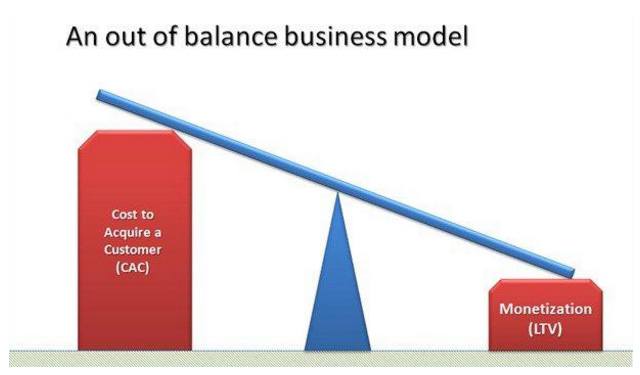
If your business model looks like this, you’re in trouble.
That’s because if you spend more money bringing in customers than they return to you down the line, your business won’t be profitable.
To determine whether or not that’s the case for you, we’ve got one more simple equation for you to try.
Figure out your customer acquisition cost (CAC) for a particular time frame:
Total marketing dollars
/
Number of customers generated
For example – if you spend $500 a month on display ads, billboards, and sponsored social media posts to gain an average of 5 clients in that same amount of time, your customer acquisition cost is $100.
(Keep in mind both these CAC and CLTV equations are very basic. If you want to get more granular with your analysis, check out this HubSpot post, and this Kissmetrics article.)
Compare your customer acquisition cost to that of your customers’ lifetime value. If your customer acquisition cost is higher than your customer lifetime value, your business model is out-of-whack.
Is yours?
Fear not, here are some ways to tip the scales back in your favor by boosting your customer lifetime value.
1. Upsell and cross-sell
Upselling and cross-selling are two great ways to increase your customers’ lifetime value. Instead of spending all your time trying to make one sale to more customers, these techniques focus on generating more sales per customer.
Upselling refers to the practice of offering your customer a more expensive version of a product or getting them to add features or warranties related to it.
Cross-selling is similar but involves selling your customer products or services from other categories to enhance the one in question.
For example, this screenshot will look familiar to anyone who’s ever shopped on Amazon:
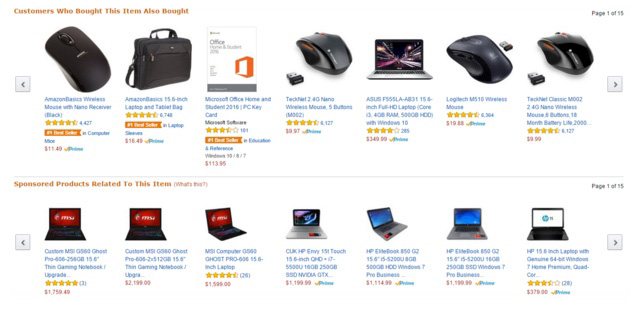
I searched “laptop” and picked the first one I could find.
When I scrolled down, Amazon tried to cross-sell me a computer mouse, a computer bag, and Microsoft Office software in the section labeled “Customers Who Bought This Item Also Bought.”
Below that, they try to upsell me with a more expensive version of the laptop I’m currently viewing in the “Sponsored Products Related To This Item.”
2. Win your customers back
We’ve all cut off a service before and received that pathetic, half-hearted email begging us to return the moment we’ve left.
Has it ever worked? Have you ever gone back immediately upon canceling?
The answer is, of course, probably not.
But that makes sense, doesn’t it? David from SalientMG aptly compares it to a real-life relationship:
“…When someone breaks up with you does it ever work when you just call them and say “take me back”? (The correct answer is NO). They broke up with you for a reason or reasons. To have a chance at getting them back you need to earn it and fix the problems. Be nice to their mom, get a haircut, get back in shape, clean the house, plan some stuff, make the effort.”
Winning your customers back works the same way.
You need to learn from your mistakes — to find your customers’ pain points. Figure out why they’re unsubscribing from your service. Then, use that information to win them back by improving it.
3. Transfer customers to lower cost channels
Once you’ve acquired a customer, there are all types of marketing automation software to help you nurture them into making additional purchases faster, and more cost-effectively, among other things.
You can use marketing automation to streamline your social media marketing, email campaigns, lead generation efforts — and even direct mail and phone campaigns.
But while this can seemingly streamline your business’ operations, it can also backfire, as Adam Ramshaw explains:
“Back when ATMs first came out in Australia, all the banks rushed to install them and move as much foot traffic to the ‘lower cost to serve’ ATM channel. This worked perfectly to lower cost. However, the banks soon discovered that they had also lost a large volume of their cross-sell opportunities. This is simply because when customers come into the branch to perform a transaction, they are more likely to set aside time to perform the transaction and so can spend a few minutes discussing other products and options with staff.”
In contrast, other attempts at cross-selling that involved phone calls and direct mail were seen as interruptions to bank customers.
Even though this is a dated example, the same can be seen in today’s marketing tactics.
For example, a brand might try to cut costs by automating all their social media marketing. However, by approaching it with a “set it and forget it” attitude, they’d risk isolating their fan base or sending the wrong message at the wrong time.
If a lot of your customers engage with you on Twitter — whether it’s to complain about your product, or to happily share pictures of themselves, you’ll miss out on valuable opportunities to boost customer experience.
Maybe an even better example is the rise of email marketing as the most popular way to nurture leads and customers. It’s a lot faster and more cost effective to hire an email marketer to send out one email to a thousand customers than it is to bring on phone representatives to call those customers all individually.
But, at the same time, your customer loses the personalized touch that comes with a phone call; and you lose the opportunity to upsell and cross-sell.
Bottom line: Meet somewhere in the middle. Automate what you can, but keep your messaging as personalized as possible.
4. Understand your customers’ journey
Use site analytics to figure out how your customers are purchasing your product. It can identify holes in your customer journey.
For example, if you see a path that looks something like:
Scenario 1: Customer lands on product page → Customer heads over to FAQ page → Customer clicks through to the support page to find your contact information
Then you can probably infer that the post-click landing page you’ve created for that particular product is incomplete. You can now go back and try to figure out how to make it more informational to avoid issues in the future.
Scenario 2: You noticed that customers tend to buy your product at a 30% higher rate after reading a case study than downloading a whitepaper. Now you know to offer them case studies instead of whitepapers in the future.
Try to discover trends in your customers’ behavior and adjust your tactics accordingly to maximize their lifetime value.
5. Deliver exceptional customer service
Too many businesses treat customer service as an afterthought, choosing to focus more on boosting their bottom line than raising customer satisfaction. But did you know that 78% of consumers have abandoned a transaction or not made an intended purchase because of bad customer service?
A blog post titled “75 Customer Service Facts, Quotes And Statistics” from Help Scout reveals the shocking cost of delivering poor customer service.
Consider some of these stats the next time you think improving your business’s customer service isn’t worth your time.
- 80% of companies say they deliver “superior customer service” and only 8% of consumers say those businesses deliver superior customer service.
There’s clearly a disconnect here. Don’t assume you’re offering good customer service, but take the time to ask your customers what they want in a customer service experience. - 45% of people will abandon an online order if they can’t find the answers to their questions right away.
Anticipate your customers’ questions and answer them before they ask you. What will they need to know before they make a purchase? Is your contact information displayed prominently? How about information on returns or the product’s warranty? Make sure you cover all the bases. - 94% of all online retailers provide email customer service, and 27% of those emails are answered incorrectly.
There are two takeaways here:
- If you don’t offer email support, you should. Emailing an inquiry is much easier for a customer than waiting on hold for an hour to get your call center representatives.
- Don’t be lazy. Make sure that every time an email is received, your customer service reps take the time to read it all the way through, and respond with an intelligent and well-thought-out answer. Who knows, it might actually solve your customer’s problem!
4. Over 1 million people view tweets about customer service every week. Roughly 80% of those tweets are negative or critical in nature.
Insanity! That’s 2 million eyeballs reading about your crappy customer service every week! Use tools like Mention to figure out what people are saying about your brand on social media, then do your best to resolve customer complaints like the team over at Comcast does on Twitter:
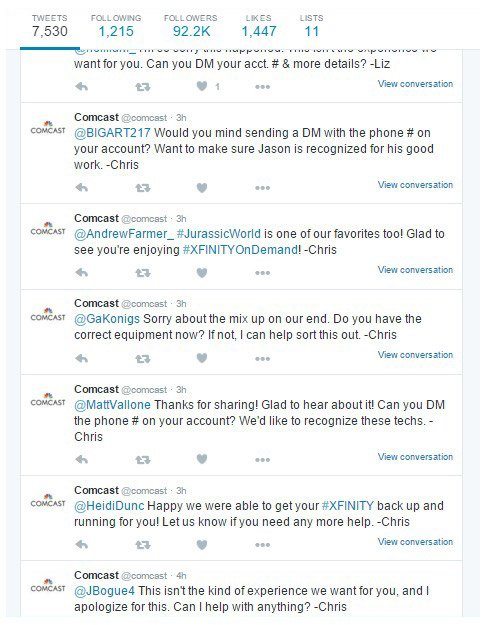
6. Offer customers something your competitors aren’t
If you’re old enough to remember what life was like before subscription streaming services, you know that in the old days you had to drive down to the local Blockbuster and rent a movie in person.
Then, in 2011, after Netflix established its streaming service, and Redbox allowed its customers to rent and return movies to a kiosk at their leisure, in-store movie rentals and sales plunged by 20%.
Five years later, you’ll have a hard time finding a movie store, as subscription streaming services like Hulu, Netflix, and Amazon Video have rendered them obsolete. Not even Redbox can compete anymore.
By 2019, experts expect that 332 million people will stream content from their homes. So, what started as an offer that nobody else in the video rental industry could match, has turned Netflix into the biggest source for on-demand content on the Internet.
Keep in mind, your offer doesn’t have to change the industry. It can be something as simple as a lower price, or a money-back guarantee. As long as it differentiates you from your competition, your customers will take note.
7. Slow down on the selling
Upselling and cross-selling are excellent techniques for boosting the lifetime value of your customers, but too much of any selling will send your customers running for the hills.
Your relationship with your customer is just that — a relationship. Treat it as such.
When you’re only focused on selling to your customers, your intentions are selfish. You want them to buy more so you can make more. It’s a “me, me, me” kind of attitude.
Imagine being in a relationship with someone like this, whether it’s with a friend, family member, or significant other. Every time you do something together it’s what they want to do. Every time they open their mouth it’s to talk about something in their life. They never give you a second thought.
A relationship like this is doomed to fail because it’s missing compromise. There’s a give and take in every interpersonal relationship, the same way there is in every brand-customer relationship.
If right now you’re thinking to yourself, “But I give them my product and take their money. That’s how the give-and-take relationship is supposed to work in business”…then you’re wrong.
Focus less on selling and more on providing your customers with valuable information at no cost.
By educating them on ways to solve problems related to your product, you’re positioning your business as a valuable resource the way someone would position himself as a friend by providing you with good advice.
For example, out of the 87 emails I’ve received from marketing writer Derek Halpern after signing up for his email list, I count only about 10 of them that try to sell me a membership to his course:
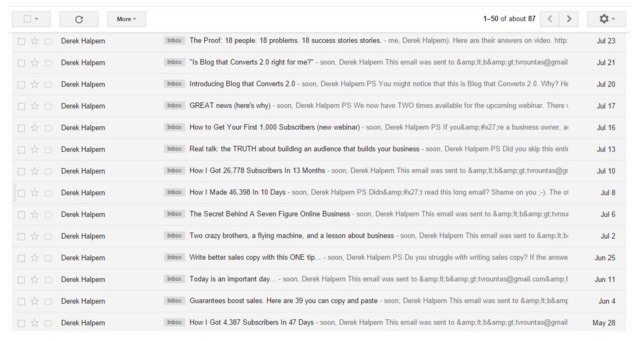
The rest are all filled with FREE valuable content that teaches me things like how to create a seven-figure online business, build a successful blog, and write more convincing copy.
Take a page out of Derek’s book and offer your customers helpful resources like free webinars, copy-and-paste templates, and step-by-step instructions on how to be successful.
8. Treat your customers like people
All this talk about this “lead”, and that “prospect”, and a new “customer” can make you forget that those things — leads, prospects, and customers — are all people.
Put yourself in their shoes. Sometimes you don’t want to take part in a sale, or be educated in the most fashionable ways to wear belts this fall. Sometimes you need to be treated like a person.
Brands like Warby Parker found out you can generate some serious exposure for your business by doing just that.
Last February, Tess Johnson showed up at a Warby Parker retail store in Atlanta to pick up new frames for her glasses. She was visibly upset, soon sharing with store associates that her car had been stolen earlier that afternoon.
A few days later, she opened her mailbox to find a $20 gift certificate to a local bar. The return address? The Warby Parker headquarters:
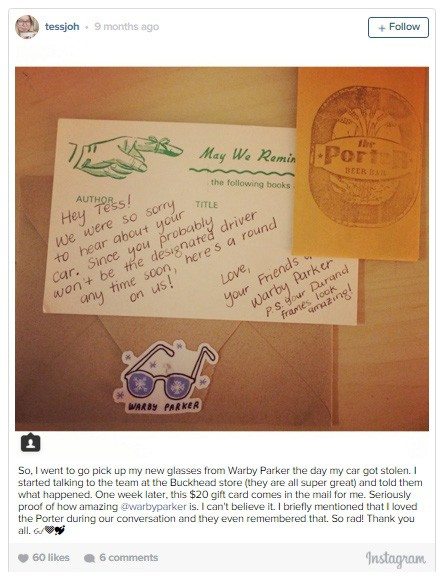
Showing just a little bit of empathy to your customers can differentiate you from the competition. It even has the potential to generate great public relations for your business, like this did for Warby Parker.
9. Manage your reviews
Research shows that 24% of American adults have posted comments or reviews online about the product or services they buy. Not only that but 90% of people indicate that reviews play a big part in their buying decision.
Make sure you’re monitoring sites like Yelp if you’re a restaurant and CNET if you’re in the technology industry and do everything you can to resolve any problems that resulted in a negative review.
Take a look at how RJ Hidson Photography responded after receiving a bad review on their Google business page:
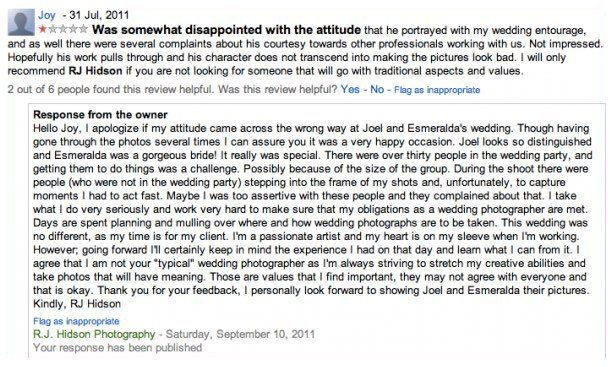
Customers will be more likely to do business with you in the future if you acknowledge you’ve made a mistake, apologize, and try to rectify it.
Keep an eye on review sites for your industry, but don’t forget to look close to home. Social media sites are often the first stop for customers with an ax to grind about your product or service.
10. Create a loyalty program
As far as boosting the lifetime value of your customers goes, developing a loyalty program is a no-brainer.
Loyalty programs offer rewards like discounts for staying faithful to your brand. By offering those rewards, you’re encouraging your customers to spend more with your brand. And in some cases, it can be a lot more.
Research has shown that businesses with loyalty programs are 88% more profitable than those without.
They can be simple, like this stamped card that offers customers a free coffee after the purchase of nine:

Or they can be more complex as the American Airlines rewards program, which allows you to redeem miles for hotels, car rentals, magazine subscriptions, vacations, and more.
To create your own, follow the lead of these seven loyalty programs that add real value.
Wrapping up
We packed a lot into this post, so let’s do a quick review. Always remember:
1. Your customer lifetime value is how much a customer is worth to you throughout their relationship with your brand
2. Your customer lifetime value should always be higher than your customer acquisition cost
3. To maximize your customer lifetime value, try to:
– Upsell and cross-sell products to maximize your sales per customer
– Win your customers back by finding out why they left in the first place
– Transfer your customers to lower cost channels, but keep your communication as personal as possible
– Deliver amazing customer service to let your customers know they’re valued
– Offer something your competitors aren’t, like a money back guarantee, or no-hassle returns
– Slow down on the selling and focus on the brand-customer relationship
– Treat your customers like the people they are, and show empathy when necessary
– Manage your reviews to make sure you’re putting your best forward online
4. Every promotion for loyalty programs, new service offerings, and upselling products starts with a great post-click landing page.
To create one for your current customers, sign up for an Instapage Enterprise demo today.
